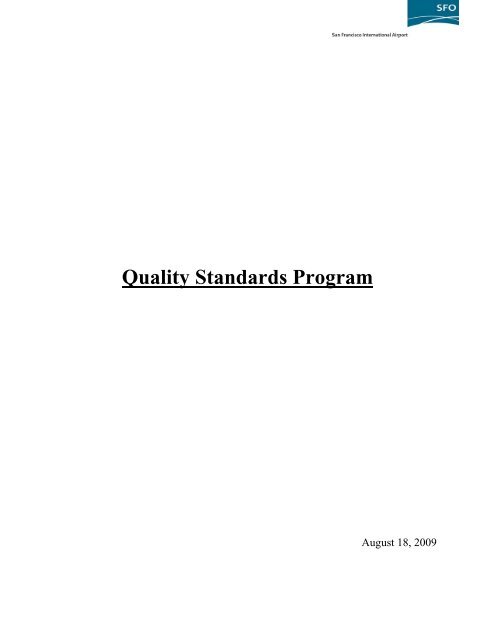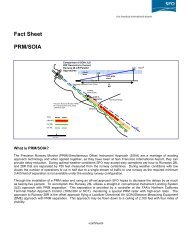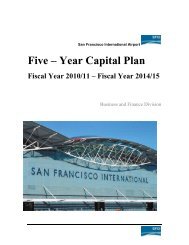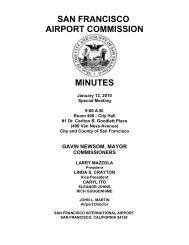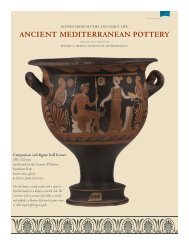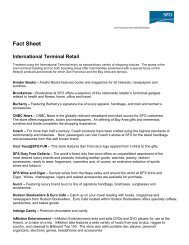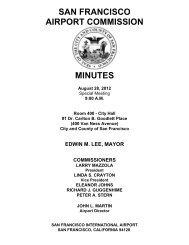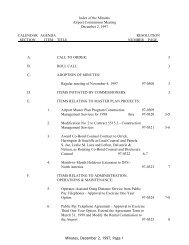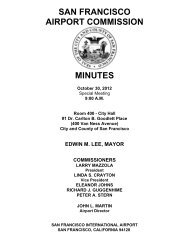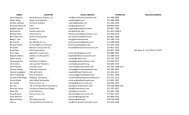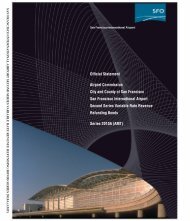Quality Standards Program (PDF) - San Francisco International Airport
Quality Standards Program (PDF) - San Francisco International Airport
Quality Standards Program (PDF) - San Francisco International Airport
- No tags were found...
Create successful ePaper yourself
Turn your PDF publications into a flip-book with our unique Google optimized e-Paper software.
<strong>Quality</strong> <strong>Standards</strong> <strong>Program</strong>August 18, 2009
<strong>San</strong> <strong>Francisco</strong> <strong>International</strong> <strong>Airport</strong><strong>Quality</strong> <strong>Standards</strong> <strong>Program</strong>August 18, 2009Page 1 of 5OverviewGeneral <strong>Standards</strong>The <strong>San</strong> <strong>Francisco</strong> <strong>Airport</strong> Commission has adopted the <strong>Quality</strong> <strong>Standards</strong><strong>Program</strong> (“QSP” or “<strong>Program</strong>”) as referenced in the <strong>Airport</strong> Rules andRegulations. The <strong>Program</strong> is being implemented to enhance security andsafety at <strong>San</strong> <strong>Francisco</strong> <strong>International</strong> <strong>Airport</strong>. The <strong>Program</strong> applies to anyfirm, including airlines and their service providers 1 (collectively, “CoveredEmployers”) which employ personnel involved in performing services whichdirectly impact safety and/or security.The <strong>Program</strong> is part of the <strong>Airport</strong>’s Rules and Regulations. CoveredEmployers will still be required to be in compliance with all other applicable<strong>Airport</strong> operating requirements, including those in their respective leases andpermits, Rules and Regulations, and <strong>Airport</strong> Directives.The <strong>Program</strong> will focus on four general areas:Section• Hiring practices• Training• Equipment standards• CompensationGeneral <strong>Standards</strong>High School Diploma or equivalent workexperienceEnglish proficiencyInitial Training <strong>Program</strong>, Recurrent Training<strong>Program</strong> and record retention guidelinesRoutine maintenance programResponse time for non-routine maintenanceA User Check LogCurrently, minimum hourly wage is$12.33 with Benefits; $13.58 withoutBenefitsCompensation and BenefitsCovered Employers are required to provide a minimum compensation andbenefits offering for employees engaged in such services. Theimplementation of a compensation and benefits package in response to the<strong>Program</strong> shall not result in the reduction of the overall value of theexisting compensation and benefits program.1 The food and beverage concessionaires and retail tenants do not engage in activities that impact safety andsecurity. Some concessionaires have AOA access specifically to get to the trash compactors. The QSP nowclarifies that concessionaires are not included under covered employers.
<strong>San</strong> <strong>Francisco</strong> <strong>International</strong> <strong>Airport</strong><strong>Quality</strong> <strong>Standards</strong> <strong>Program</strong>August 18, 2009Page 2 of 5A bona fide Collective Bargaining Agreement (CBA) between coveredemployers and labor organizations representing covered employees shall takeprecedence over all or any portion of the QSP compensation and benefitsrequirements, provided that such waiver is set forth in such agreement in clearand unambiguous terms.Covered employees hired prior to August 19, 2009 will continue to receive theQSP minimum wage rate of $12.33 per hour until the QSP wage rate providedherein is no more than $.50 higher than the Minimum CompensationOrdinance (“MCO”) wage rate such that it remains $.50 higher than the MCOminimum wage rate.Covered employees employed prior to August 19, 2009, who have opted outof health insurance and, in lieu thereof, have been receiving an additional$1.25 per hour to the QSP minimum rate, shall not have their compensationreduced by the QSP provided that they submit proof of health care coveragefrom another source by April 1, 2010, and thereafter on an annual basis.Except as specifically provided hereinabove with reference to employeesemployed prior to August 19, 2009, the provisions of the QSP shall otherwiseapply in all respects to covered employees.CompensationMaintain the current minimum QSP wage rate of $12.33 until the City’s MCOrate is $.50 or less, at which time the new QSP rate shall increase such that itremains at all times $.50 above the then current MCO rate. The <strong>Airport</strong>Director will provide for an annual review of the QSP minimum wage rate,starting January 1, 2011.BenefitsQSP employers are to provide twelve (12) paid days off and ten (10) unpaiddays off per year per the MCO.All covered QSP employers must comply with the City’s Health CareAccountability Ordinance (“HCAO”) minimum health coverage standards,effective April 1, 2010. Health coverage must become effective 30 days afterthe first day of work for all covered employees hired effective April 1, 2010per the HCAO.Health Care Accountability Ordinance WaiverUnder the HCAO, employees may voluntarily waive the health care coverageoffered by an employer if the employee signs a voluntary waiver and providesa current copy of insurance certifying that s/he has health care coverage fromanother source. This proof of insurance coverage must be submitted annuallyto the employer and be available for inspection by <strong>Airport</strong> staff or QSP
<strong>San</strong> <strong>Francisco</strong> <strong>International</strong> <strong>Airport</strong><strong>Quality</strong> <strong>Standards</strong> <strong>Program</strong>August 18, 2009Page 3 of 5auditor. Employees may revoke this voluntary waiver at any time. Under theQSP, an employer is not required to pay a fee to the City if an employee signsa voluntary waiver or when a CBA takes precedence over the QSP benefitrequirements.Types of Employees Covered by the <strong>Program</strong>The <strong>Program</strong> is applicable to employees of Covered Employers who:(1) require the issuance of an <strong>Airport</strong> badge with Airfield Operations Area(“AOA”) access and work in and around the AOA in the performance of theirduties; or (2) are directly involved in passenger and facility security, includingcheckpoint screening, passenger check-in, skycap and baggage check-in andhandling services, and AOA perimeter control. The <strong>Program</strong> is applicable toall existing Covered Employers as well as new entrants.Those Impacting Security Employees in this category include those directly engaged in performingcheckpoint security screening, passenger check-in activities, skycap andbaggage check-in and handling services, and AOA perimeter control.Part 1544 of the Transportation Safety Regulations (“TSR”) governs aircarriers and their Covered Employers and sets forth basic quality standards forall areas outlined above, except compensation. <strong>Airport</strong> Staff has developedenhanced quality standards for Covered Employers in this category to ensurethe highest level of security at <strong>San</strong> <strong>Francisco</strong> <strong>International</strong> <strong>Airport</strong>. <strong>Standards</strong>will be deemed updated to reflect changes in TSR Part 1544 or other changesto TSR which may be pertinent to the application of this program to coveredemployees.<strong>Standards</strong> for Covered Employers in this category are on Attachment A.Those Impacting SafetyEmployees in this category include those directly engaged in activities, whichmay impact safety within the AOA. These employees include but are notlimited to the following: Employees providing ramp handling functions including aircraft cleaning,fueling, and baggage/cargo handling Employees operating catering vehicles regularly on the AOA for thepurpose of servicing aircraft Other employees issued an <strong>Airport</strong> badge with AOA access working inand around the AOA in the performance of their duties<strong>Standards</strong> for Covered Employers in this category are on Attachment B.
<strong>San</strong> <strong>Francisco</strong> <strong>International</strong> <strong>Airport</strong><strong>Quality</strong> <strong>Standards</strong> <strong>Program</strong>August 18, 2009Page 4 of 5ProcessCertificationA certification process will include meeting with QSP staff to review the<strong>Program</strong>. The criteria outlined on Attachments A and/or B will be reviewedwith each covered employer by the <strong>Airport</strong>’s Airfield Operations and AviationSecurity staff.Third Party VendorsWhen staff is satisfied that a Covered Employer in this category is incompliance with the <strong>Program</strong>, an operating permit will be issued. Any airlinedesiring to contract for these types of services with a third party vendor thathas not yet been certified must contact Aviation Management to begin thereview process. The operating permit will outline the permitted services aswell as the conditions under which business must be conducted at the <strong>Airport</strong>.Airlines and Service ProvidersLessee and permittees are required to comply with the <strong>Airport</strong> Rules andRegulations, including the <strong>Program</strong>, pursuant to their respective agreements.Annual Certification and Audit RightsEach year, each Covered Employer shall deliver to the <strong>Airport</strong> Director astatement certifying that it is in compliance with the <strong>Program</strong>. The <strong>Airport</strong>reserves the right to review and audit such compliance at any time. <strong>Airport</strong>staff will conduct all audits to ensure continuing compliance. If at any time aCovered Employer is found to be out of compliance, the <strong>Airport</strong> will givenotice to the Covered Employer and allow a reasonable cure period to addressthe noted deficiency, unless such deficiency is considered an endangerment, atwhich point operations must cease until the deficiency is corrected. Suchnotice to third party Covered Employers will include a copy to all knownairlines contracting for the Covered Employer’s service at the <strong>Airport</strong>.DefaultAny non-compliance with the <strong>Program</strong> will be considered a default under theCovered Employer’s agreement with the <strong>Airport</strong>. If the default is not curedwithin the time period specified in the <strong>Airport</strong>’s notice, the <strong>Airport</strong> mayexercise all remedies available to it including but not limited to the impositionof fines and the termination of any and all agreements with the <strong>Airport</strong>.Non-ComplianceUpon receipt of any notice of non-compliance with the <strong>Program</strong>, the CoveredEmployer must promptly take action to cure such non-compliance. If the nonconformanceis not cured within the time period specified in the <strong>Airport</strong>’s
<strong>San</strong> <strong>Francisco</strong> <strong>International</strong> <strong>Airport</strong><strong>Quality</strong> <strong>Standards</strong> <strong>Program</strong>August 18, 2009Page 5 of 5notice, the <strong>Airport</strong> may exercise all remedies available to it including but notlimited to the imposition of fines, restitution for employee back wages,interest on all due and unpaid wages (per the State Labor Code) and thetermination of any and all agreements with the <strong>Airport</strong>.FinesIf a Covered Employer defaults with respect to any requirement of the<strong>Program</strong>, the <strong>Airport</strong> Director may elect to impose a fine equal to $200.00 perviolation, per day. The <strong>Airport</strong>’s right to impose such fines shall be inaddition to and not in lieu of any and all other rights available to the <strong>Airport</strong>.Such fine amount may be increased from time to time at the discretion of the<strong>Airport</strong> Director.Employer Retaliation ProhibitedCovered Employers shall not discharge, reduce in compensation, or otherwisediscriminate or retaliate against any covered employee for notifying the<strong>Airport</strong> about a Covered Employer’s noncompliance or anticipatednoncompliance with the <strong>Program</strong>, for opposing any practice proscribed by the<strong>Program</strong>, for participating in proceedings related to the <strong>Program</strong>, or forasserting his/her rights under the <strong>Program</strong> by any lawful means.
Attachment AAIRPORT QUALITY STANDARDS PROGRAMCovered Employers Impacting Aviation Security 1. General <strong>Standards</strong>a. Provide a local management (in most cases, the authorized signatory) point ofcontact, telephone number and email, and immediately notify Aviation Securityof any changes.b. Provide name, 24-hour telephone and email of Company SecurityDirector/Manager, and immediately notify Aviation Security of any changes.c. Telephone notification to Security Access Office of:i. terminated employeesii. lost/stolen badgesiii. lost/stolen <strong>Airport</strong>-issued security keys.d. Immediately return terminated employee <strong>Airport</strong> I.D. badge and (if applicable)<strong>Airport</strong>-issued security keys to Security Access Office.2. Personnela. Background investigation requirements include:i. All employees must undergo and pass TSA Criminal History RecordsChecks and Security Threat Assessment prior to issuing an <strong>Airport</strong> I.D.badge.ii. If company mandated drug testing is performed, provide name andaddress of the facility and frequency.3. Traininga. Company personnel must complete <strong>Airport</strong> training which includes:i. Computer-based Security Identification Display Area training, for AOAbadgeapplicants, or computer-based Security Awareness Training forSterile and Terminal badge applicants.b. Describe and provide sample materials from employee orientation trainingprogram that includes:i. <strong>Airport</strong> Rules and Regulationsii. SFO “Security Enforcement <strong>Program</strong>”iii. SFO “Use of <strong>Airport</strong> ID Media and “ESCORT” Authority Proceduresiv. Other relevant <strong>Airport</strong> Operations Bulletins or Security Directivesv. For employees with AOA access, pedestrian safety traininghighlighting all hazards including moving vehicles, jet bridgemovement areas, and the purpose of warning bells and warning lights.4. Equipment <strong>Standards</strong>On an annual basis at the end of the calendar year, provide inventory to SecurityAccess Office of all AOA vehicles requiring ramp pass.Attachment A Page 1
Attachment BAIRPORT QUALITY STANDARDS PROGRAMCovered Employers Impacting Airfield Safety 1. General <strong>Standards</strong>a. Provide a site (on or adjacent to the <strong>Airport</strong>) for scheduled and unscheduledrepairs and maintenance of company equipment.b. Secure <strong>Airport</strong> approval for an area to stage equipment when not in use.c. Supply <strong>Airport</strong> with names, titles and 24-hour phone numbers of managementand shift supervisory personnel.2. Personnela. Company personnel who perform job functions in the covered categories mustmeet the following criteria:i. High School graduate, GED, or an equivalent combination ofeducation and experience;ii. Be physically fit to perform the duties of the job;iii. Be proficient in English.b. Personnel whose job duties require operation of a motor vehicle on theAirfield must also:i. Possess a valid California Drivers License;ii. Successfully complete all <strong>Airport</strong> Security Access Office requirements(training & tests) to obtain <strong>Airport</strong> AOA driving privileges;iii. Cannot have a reckless driving or DUI conviction within previous 24months.c. Companies with personnel who operate motor vehicles on the Airfield mustalso enroll in the California Department of Motor Vehicles “Pull <strong>Program</strong>” toreceive notification should their personnel lose their California Drivers’Privileges.3. Traininga. In addition to TSA mandated SIDA training administered by the <strong>Airport</strong>,covered companies must have an approved new employee training programthat includes <strong>Airport</strong> Rules and Regulations governing:Attachment B Page 1
i. Security Awareness & Security Identification Display Area (SIDA)requirementsii. Vehicle Operationsiii. Aircraft Operationsiv. Hazardous Materials handling proceduresv. Litter, FOD, and debris control.b. Training program must also include:i. Ground service equipment operationii. Safe driving on the AOA (video)iii. Interline baggage operationsiv.Pedestrian safety training highlighting all hazards including movingvehicles, jet bridge movement areas, and the purpose of warning bellsand warning lightsv. Training on provisions of <strong>Airport</strong> Vehicle Impound <strong>Program</strong>vi. Fueling procedures.4. Recurrent Traininga. Must conduct recurrent training on a minimum of an annual basis;b. Must conduct safety meetings on a minimum of a monthly basis.5. Equipment <strong>Standards</strong>a. Maintenance – must have a GSE (Ground Service Equipment) PreventativeMaintenance <strong>Program</strong> that includes the following:i. Periodic safety inspection schedules for each type of motorizedequipment;ii. Procedures for taking mechanically unsound equipment “out ofservice”; andiii. Daily User Check <strong>Program</strong> for each type of motorized equipment.This checklist must include provisions for inspection of:• Tires• Head, tail and brake lights• Horn• Parking brake• Handrails and guards• Walk-around fluid leak check.b. Maintain all GSE maintenance records for a minimum of 24 months.c. Inventory – provide the SFIA Security Access Office an inventory listing ofall motorized equipment annually.d. Will be subject to the provisions/standards contained in the <strong>Airport</strong> VehicleAudit Oversight <strong>Program</strong> and the Vehicle Impound program.Attachment B Page 2
6. <strong>Quality</strong> <strong>Standards</strong> - Handling Service Providers - Management andOversighta. Each vendor shall establish and carry out an internal quality assuranceprogram to include:i. A procedure to monitor performance, including incident reports andpersonnel feedback, to identify existing problems or potential causesof problems in assigned security duties;ii. A procedure for corrective action to ensure that existing problems thathave been identified are corrected;iii. A procedure for preventive action to ensure that potential causes ofproblems that have been identified are remedied;iv. An internal audit program to audit the vendor’s organization forcompliance with (1) Federal regulations and security programs and (2)<strong>Airport</strong> requirements;v. Unless otherwise authorized by the <strong>Airport</strong>, a director of qualityassurance who is independent from operations and training functionsand who manages the quality assurance program;vi. Will have a representative in attendance at monthly ramp safetymeetings.b. Annually, and upon change of assignment or required information, the QSPcovered employer shall identify to the <strong>Airport</strong> the name, address, telephone,fax number, and e-mail address, if applicable, of a regional or corporateemployee performing the quality assurance functions identified above.c. All permitted use space must be maintained in a clean and safe condition.Ramp areas must be scrubbed as needed, fence lines clear of trash and anyoutside equipment storage/maintenance areas maintained in a professionalmanner.Attachment B Page 3


